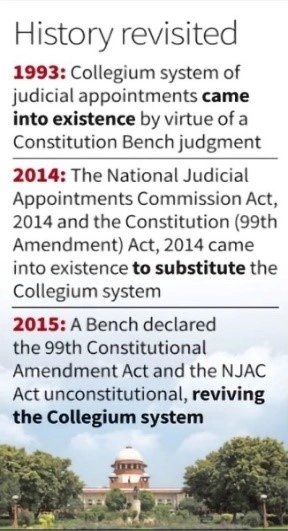Context:
The Supreme Court recently agreed to examine a PIL that challenges the Collegium system for appointing judges to the Supreme Court and High Courts and seeks the reinstatement of the National Judicial Appointments Commission (NJAC).
Background:
-
- In 2014, Parliament passed the 99th Constitutional Amendment and the NJAC Act to replace the Collegium System for appointments to the higher judiciary.
- However, in October 2015, a five‑judge Constitution Bench of the Supreme Court struck down NJAC, declaring the amendment and Act “unconstitutional and void,” restoring the Collegium System.
- Since then, judicial appointments have been made under the Collegium System, where senior judges recommend and select new judges — giving the judiciary primacy and perceived insulation from executive interference.
- In 2014, Parliament passed the 99th Constitutional Amendment and the NJAC Act to replace the Collegium System for appointments to the higher judiciary.
About National Judicial Appointments Commission (NJAC):
The NJAC was a proposed constitutional body for judicial appointments, established by the 99th Constitutional Amendment Act, 2014, to replace the collegium system.
-
- Purpose: To create a more transparent and accountable system for appointing judges to the Supreme Court and High Courts, replacing the collegium system.
- Composition: It was a six-member body consisting of the Chief Justice of India, two senior-most Supreme Court judges, the Union Law Minister, and two eminent persons nominated by a committee of the CJI, Prime Minister, and Leader of the Opposition.
- Key feature: It included a veto power where any two members could reject a recommendation.
- Purpose: To create a more transparent and accountable system for appointing judges to the Supreme Court and High Courts, replacing the collegium system.
Significance of this Move:
-
- Re‑opening Debate on Judiciary‑Executive Balance: If the Court accepts the plea, it could reignite debate on whether the executive and/or the legislature should have a formal role alongside the judiciary in selecting judges — addressing long‑standing concerns of opacity in the Collegium System.
- Transparency, Accountability & Public Trust: A revived NJAC (or a reformed appointment mechanism) might improve transparency, widen the base for judicial appointments beyond a closed group, and help reduce perceptions of favouritism — enhancing legitimacy of the judiciary.
- Impact on Separation of Powers & Judicial Independence: Any move to involve non‑judicial actors in appointments will raise constitutional questions about separation of powers. The 2015 verdict rejected NJAC on these grounds. Revisiting the issue could lead to a re‑examination of what constitutes “basic structure” under the Constitution.
- Re‑opening Debate on Judiciary‑Executive Balance: If the Court accepts the plea, it could reignite debate on whether the executive and/or the legislature should have a formal role alongside the judiciary in selecting judges — addressing long‑standing concerns of opacity in the Collegium System.
Conclusion:
A new mechanism could influence who becomes judges — impacting bench composition, diversity, and overall judicial functioning. This could affect long‑term issues like case backlog, regional representation, social justice adjudication.







